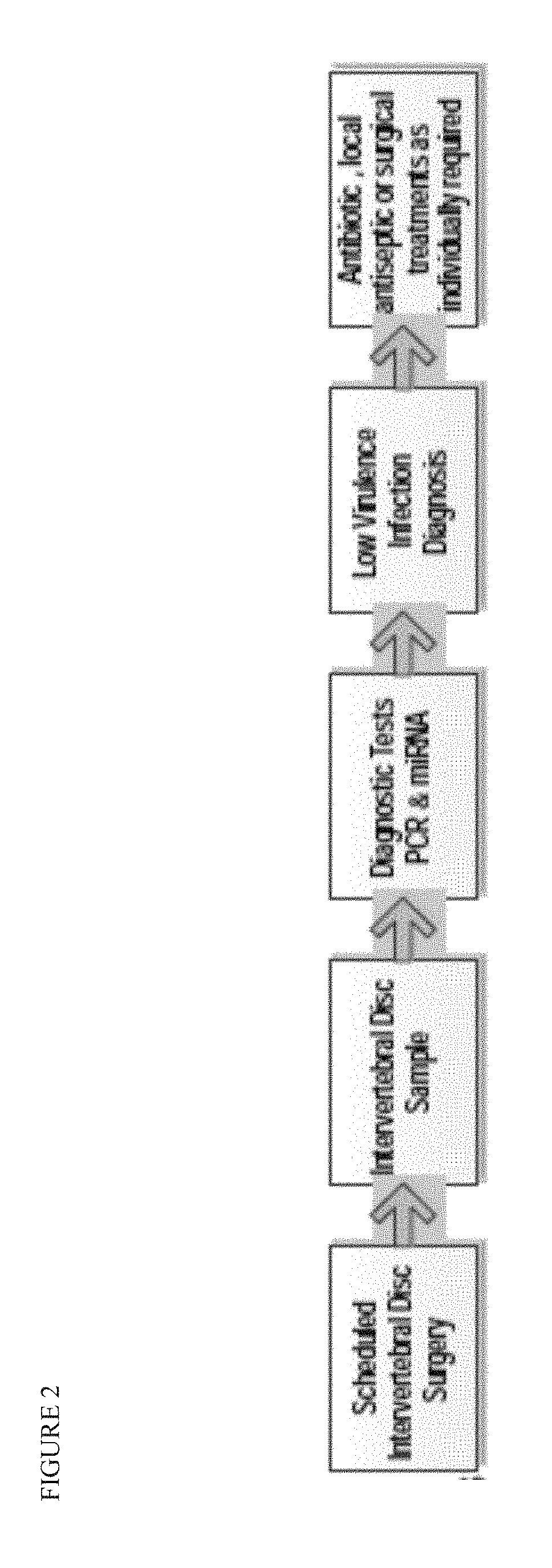Methods for detecting and treating low-virulence infections
a low-virulence infection and detection method technology, applied in the field of low-virulence infections, can solve the problems of unacceptably high false positive rate and the vast majority of microorganisms that cannot be cultured under standard conditions used for diagnostic purposes, and achieve the effect of reducing the need for more invasive procedures
- Summary
- Abstract
- Description
- Claims
- Application Information
AI Technical Summary
Benefits of technology
Problems solved by technology
Method used
Image
Examples
example 1
MicroRNA (miRNA) In Vitro Profiling
[0073](1) NP cells derived from 3 samples of native disc tissue are infected by P. acnes (PA) (ATCC 6919, derived from facial acne), or PA derived directly from infected disc tissues, and with other bacterial species (e.g., E. coli, Staphylococcus, Corynebacterium).
[0074](2) Bacterial intracellular occurrence is evaluated by cytokine response and DAPI staining at various time-points.
[0075](3) Identify microRNA profile induced by bacteria in intracellular space. A first profile (Profile 1a) is the profile common for all bacterial species, and a second profile (Profile 1b) is the profile specific for P. acnes, or E. coli etc., for detection of contamination in tissue samples.
[0076](4) Identify microRNA profiles (Profile 1a and Profile 1b) in different time points after infection of NP cell cultures. 30-60 minutes may be used as a model for acute infection, to identify profiles indicative of contamination which occur prior to sample fixation (e.g., in...
example 2
miRNA Fresh Intervertebral Disc Tissue Profiling
[0078](1) Enrollment of ˜500 patients undergoing disc surgery in Czech Republic, with clinical data collection at the time of surgery and follow-up in 6 weeks, and 6 and 12 months.
[0079](2) Divide each tissue sample into 3 portions:[0080]1. For DNA purification and qPCR evaluation of bacterial DNA event. For Metagenomic approach, DNA is stored at −80° C. immediately after extraction.[0081]2. For RNA purification and qPCR evaluation of microRNA profiles. RNA is collected with stabilizing solution (RNAlater)[0082]3. For microbiological evaluation, tissue will be transported at room temperature to Microbiology department as soon as possible.
[0083]For future research, blood plasma and urine are also collected and stored at −80° C.
[0084](3) Sample 1 will be used for DNA purification and in all samples will be quantified for P. acnes DNA by qPCR. In addition, other bacterial species, such as staphylococci, can be quantified.
[0085](4) In samp...
example 3
Cross-Validation of Positivity in the Whole Cohort
[0090]In 500 samples there will be: N patients positive by cultivation, and N1 positive by qPCR. A diagnostic algorithm based on identified microRNA signatures will be developed. N3 patients will be positive by miRNA signature.
[0091]In cases positive for common miRNA signature, PA-specific and staph-specific miRNA signatures will be evaluated. From N3 positive for common signature: N4 will be positive for PA-specific miRNA signature; N5 will be positive for Staph-specific miRNA signature; N6 will be negative for both. N6 will be subjected to metagenomic analysis.
[0092]The following observations are expected: a higher frequency of true positivity in patients undergoing surgery with history of CLBP, and higher frequency of true positivity in patients with failed back surgery and especially in those who will suffer with CLBP (after evaluation of clinical outcome at 6 and 12 months).
PUM
| Property | Measurement | Unit |
|---|---|---|
| sizes | aaaaa | aaaaa |
| wet weight | aaaaa | aaaaa |
| wet weight | aaaaa | aaaaa |
Abstract
Description
Claims
Application Information
 Login to View More
Login to View More - R&D Engineer
- R&D Manager
- IP Professional
- Industry Leading Data Capabilities
- Powerful AI technology
- Patent DNA Extraction
Browse by: Latest US Patents, China's latest patents, Technical Efficacy Thesaurus, Application Domain, Technology Topic, Popular Technical Reports.
© 2024 PatSnap. All rights reserved.Legal|Privacy policy|Modern Slavery Act Transparency Statement|Sitemap|About US| Contact US: help@patsnap.com










